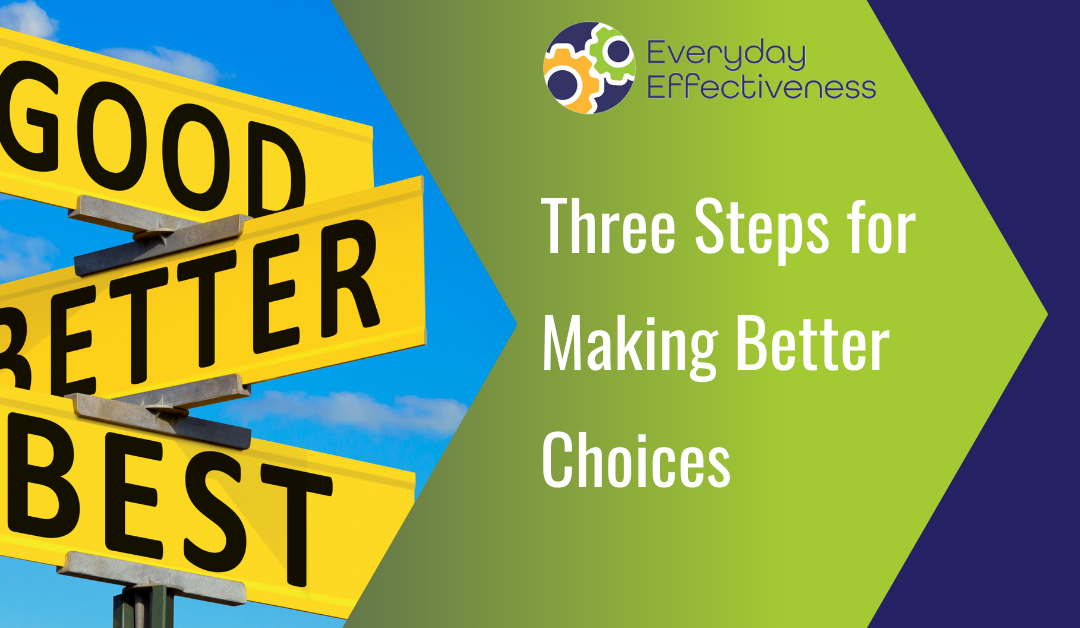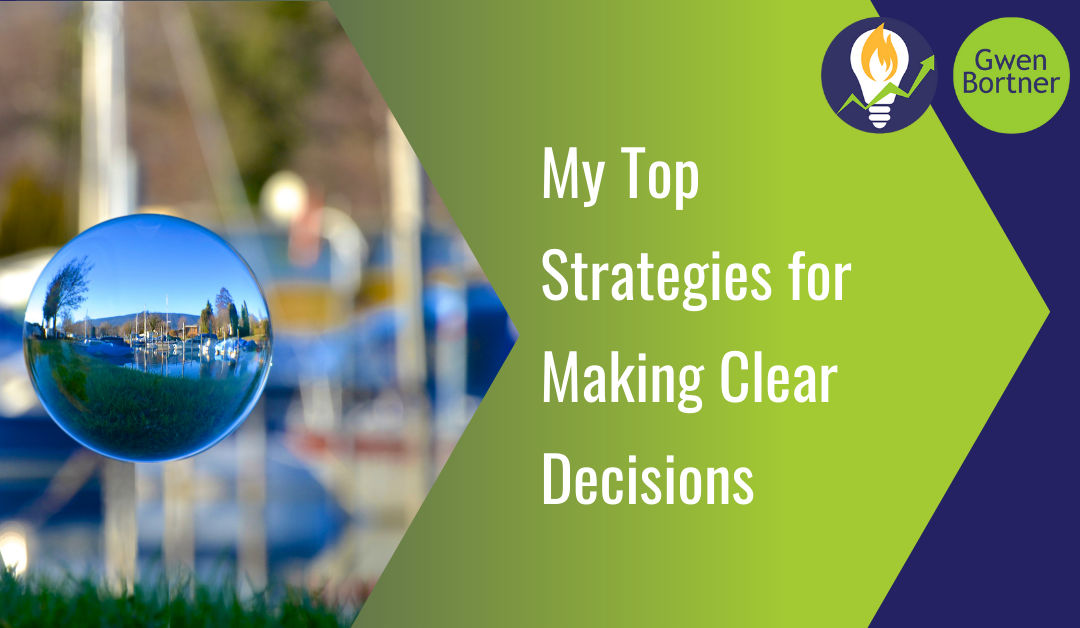
by Gwen Bortner | Leadership, Tips & Tricks
Do you struggle to make decisions for your life or business, because you never know if you’re making the “right” choice? The truth is, you may never know if you made THE “right choice” at the moment, and chances are there’s more than one option that could be right for you, depending on the circumstances. You don’t get to make two choices at once and test them against one another like a science experiment, so you have to just take a deep breath and choose the option that feels the most right and go forward from there.
Previously, I’ve talked about the biggest obstacles that hold you back from making a decision. Now, I want to give you some tips for narrowing down your choices and getting clear on the most right decision for you and your business, no matter what your options are.
How to Make Better Choices
Take Your Time
Things tend to feel very urgent in the moment. There’s a deadline looming, or you’re caught up in the idea that you’re going to miss some significant opportunity if you don’t figure out all the choices right now. In reality, we often create a false sense of urgency when we’re struggling with a decision, and it’s usually not even necessary. Opportunity does knock twice, no matter what people might tell you, and there is always another train to catch. Give yourself the time and mental space you need to make a decision because rushing through the process usually results in negative outcomes.
Eliminate Emotions
Whether you’re a “Star Trek” fan or not, chances are you’re at least a little familiar with the character Spock, who is from the planet Vulcan. The Vulcans are known for having eliminated their emotional responses to every situation through a rigorous system of meditation and a focus on logic. You may not be able to channel your inner Vulcan, but in many cases, an emotional response may be clouding your vision when making a decision. Take a few minutes to journal about the feelings associated with a decision, and it may bring a lot of clarity on why you’re feeling stuck. You shouldn’t discount your emotions entirely – after all, your “gut feeling” may be leading you in the right direction. However, you also don’t want to make decisions based solely on emotions, because they have the power to affect your judgment. Once you can identify what you’re feeling, it gets easier to separate yourself from that emotion and move forward with a decision that is rooted in logic.
Narrow Your Options
In your school days, if you had to take a multiple-choice test, the best strategy was to start by eliminating some of your options. Usually, those types of tests had at least one answer choice that was obviously wrong, if you just took the time to evaluate it. The same strategy can be applied to your decision-making; if you narrow down your options, you can make an easier decision based on what’s left over after you’ve eliminated the choices that are obviously wrong for you and your business.
If you’ve given yourself time and space, you’ve identified your feelings and balanced them with logic, and you’ve narrowed down your options, you can then make a decision knowing that you have thought through your options completely.
As an entrepreneur, you face many choices in all areas of your business every day. Sometimes it’s not clear which part of your business you should start with. Take the GEARS Assessment today to help you identify which area needs your attention before the others.

by Gwen Bortner | Leadership, Tips & Tricks
In my last post, I outlined the biggest obstacles we face when we have to make a tough decision (click here if you haven’t read that one yet). This is also a follow-up to the piece I wrote for APeeling Magazine; if you’d like to read the original piece, click here.
Knowing what’s holding you back from making a big decision is half the battle – but it’s only the first half. It helps to give you clarity and insight, and to move past any emotional or tangible roadblocks you may be facing. Now that you know what’s holding you back, your next task is to actually make the decision, and that’s where it can be tricky.
Today, I’m sharing my top strategies for making decisions when there isn’t a clearly “right” answer. I have used these strategies to set business goals, make decisions that would move my company forward, and even to make challenging personal decisions. Maybe one of these strategies will help you in a similar situation – make sure to bookmark this page so you can come back to it when you’ve got to make a big decision.
Strategies to Help You Make Better Decisions
The Stair-Step Method
This one is for a decision where there are multiple options, and you’re not sure how to choose between so many possibilities. For this strategy, make a list of your options and number them in order. The trick is, instead of trying to look at every possibility all together, you’re going to narrow it down one pair at a time. Look only at choice #1 and choice #2. Pick the best option JUST between those two. Now, put the winner of that contest up against choice #3, and pick the best option only between those two. Repeat this process until you reach the bottom of your list. The winner of the final 1-on-1 contest is the choice you’re going to pick. (Note: you don’t go back through the list and pair them up differently a second time; you get to the bottom and that’s it. Like a sports bracket, there’s one clear winner, and the match-ups don’t get shuffled around after the final game.)
Beyond the Pros and Cons
Chances are, if you’ve been stuck on a decision for any length of time, you’ve probably already tried making a pro/con list, and you still don’t have enough clarity to make the decision. If you’re trying to make a “yes or no” decision, try this strategy instead, which is a twist on the classic pro vs. con list. Divide your paper into four sections and label them like so: pro/want, pro/need, con/want, and con/need. Now, you still brainstorm a list of pros and cons, but you associate each one with something you want or something you need. This can be especially helpful if you’re making a decision that involves doing something difficult that you don’t really want to do, but you know it will move you forward. Breaking the pros and cons up into four different categories can give you clarity on the strongest options between them, and can also help you see if you’re holding yourself back from a decision because it isn’t really what you want to do.
Short vs. Long Term
Use this strategy when you’re choosing between two options that have a lot in common. The similarity between them is likely what’s holding you back from picking one in the first place, so this strategy can really help with that. For each option, make a list of short-term wins and long-term wins if you were to choose that option. When you compare them side-by-side, it can be easier to see the overall benefit of each choice. Do you really need a short-term win in order to get over an immediate hurdle, or will your business benefit overall if you play the long game and wait for a win that takes more time? As you’re evaluating the options, ask yourself: will you be glad you made this choice in 3 months, 6 months, a year? The phrase I use is: Will Tomorrow Me thank Today Me for this decision? This can help you really weigh the options and make the best choice.
If you’re still struggling, you may be putting far too much emphasis on one single decision. In almost every situation, you will have an opportunity to choose differently at some point in the future. There will likely be a cost – of time, money, or opportunity – but there will be a time when you can reverse a decision or take a different path. It’s very rare that a decision is both life-changing AND permanent, but sometimes it can feel that way in the moment.
If you struggle with making decisions, adding these strategies to your toolkit should help you make confident choices to move your business forward. If you still need some help, sometimes the best thing you can do is bring in an outside perspective; someone else who isn’t emotionally attached to the outcome of your decision can bring clarity to the situation that you may not be able to find on your own. If you’d like some help with your decision-making, click here to book a 1-on-1 coaching session with me. Let’s tackle this problem together!



